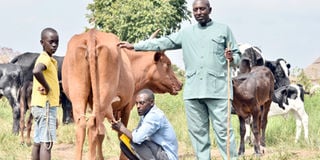Prime
Experts tips on family farming

Involving family members helps in the survival of family farms. Photo | George Katongole.
What you need to know:
- Most smallholder farmers in Uganda have the factors of production including labour, land and capital as well as entrepreneurship. Experts note that their use is what makes the difference. The recipe for success is that farmers take up family farming to meet current challenges.
Family farming is the predominant form of food and agricultural production in both developed and developing countries, producing an estimated 80 percent of the world’s food.
70 percent of the farms in Uganda can be characterised as family farms majority being managed and operated by a family and predominately reliant on family capital and labour.
Family farms have adherent capacity to transfer skills, knowledge, land and other production factors through inheritance.
Family farmers hold unique potential to become key agents of development strategies since it has the potential of solving the utmost factors affecting agriculture today.
However, the Multidimensional nature of family farming makes it more complex and many conflicts arise due to poor/lack of better framework conditions that guide family farmer’s on how to ensure the smooth transfer of their farms to the new generations.
Many conflicts are triggered by unresolved inheritance disputes, often complicated by polygamous family relationships.
When the family head dies, land is inevitably divided and sold in small chunks making future production complicated. If land is divided over generations, the fields become too small to give sufficient yield.
The transfer of farm, land, livestock and means of production in such cases only makes sense, if the quality of the land and the business model allows for an increase in production.
Dr Sadick Kassim, the National Agricultural Research Organisation (Naro) Deputy Director General, Agriculture Technology Promotion, says that farmers must embrace family farms.
During the Seeds of Gold Farm Clinic held at Ngetta Zonal Agricultural Research and Development Institute (ZARDI) Dr Kassim points out that efforts to eliminate hunger and malnutrition start with proper handling of family farms.
“Family farmers need to be at the centre of efforts to transform food systems if we are to make real progress towards ending hunger,” Dr Kassim says.
He notes that family farming is the main form of agriculture globally and is responsible for producing 80 percent of the world’s food.
A struggle
According to the World Food Programme (WFP), as many as 828 million people go to bed hungry every night. The number of those facing acute food insecurity has soared - from 135 million to 345 million - since 2019.
Dr Kassim says, family farmers are subject to the new challenges created by the climate crisis.
He says the unique role of family farmers in transforming the food systems is important in achieving Sustainable Development Goals.
But he is concerned that often, family farmers struggle to feed their own families.
“As government takes its part we need to see how we adopt. Researchers have embarked on climate-smart technologies. Farmers must look out for suitable crops,” Dr Kassim notes.
He says that Naro hosts platforms to facilitate the exchange of experience, innovation and specialised knowledge.
Push for the future
He says that farrmers should sisely invest their money
“You should use the money to invest instead of keeping it in the bank for an interest. You should also consider consolidating labour in family farming. As a family you can agree on the best enterprise, such as soybean, you can pursue together and set the plan together and each day you work together to produce, harvest together and store together,” he says.
Dr Kassim notes that the challenge is that in many families the husband does not want the wife to know how much money he has.
“Eventually when you die the farm will not be inherited because none of your family members has knowledge about its operation,” he says.




